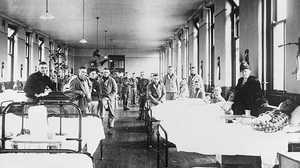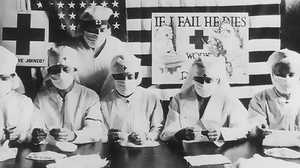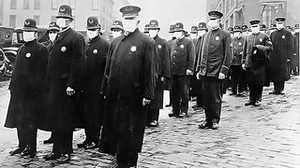The Flu in Philadelphia

Officials in Philadelphia knew what was coming their way. All through September 1918 they had seen reports coming out of Boston of a virulent, deadly influenza. In fact, the Philadelphia Bureau of Public Health had issued a bulletin about the so-called Spanish influenza as early as July 1918. Despite the prescience of some, Philadelphia’s health and city officials had failed to even list influenza as a reportable disease, placing the city’s population of nearly two million in grave danger.
The timing of the epidemic’s arrival in Philadelphia could not have been worse. Over one-quarter of the city’s doctors, and a larger portion of its nurses, were lending their medical talents to the nation’s war efforts. At Philadelphia Hospital, 75% of medical and support staff were overseas. Such personnel shortages were an issue even before influenza had hit; once it did, lack of adequate medical help contributed to influenza’s deadly impact.
Misinformation, and perhaps wishful thinking, added fuel to the influenza’s fire. While the Bureau of Health was issuing directives concerning public coughing, sneezing, and spitting, Dr. A.A. Cairns and Wilmer Krusen of the Department of Health and Charities were assuring the public that the illness would not spread beyond military personnel. In late September, Dr. Paul Lewis, director of the Philips Institute of Philadelphia, aroused great hope by declaring that he had identified the cause of this influenza: Pfeiffer’s bacillus. The confidence of the medical community quickly spilled over into the general population — with dire consequences.
On September 28, 200,000 people gathered for a fourth Liberty Loan Drive. Funding the war effort and showing one’s patriotic colors took precedence over concern for public health. Just days after the parade, 635 new cases of influenza were reported. Two days later, the city was forced to admit that epidemic conditions did indeed exist. Churches, schools, and theaters were ordered closed, along with all places of “public amusement.” Members of the press condemned the closings as a violation of common sense and personal freedom. Meanwhile, the ranks of the sick and dying continued to grow. By mid-October, their numbers ran into the hundreds of thousands. Hospitals quickly reached capacity. Church parish houses and state armories doubled as shelters for the sick.
Just as medical facilities were pushed to the brink, so too were medical personnel. Able-bodied doctors were summoned from retirement, while novice medical students were plucked from their studies to tend to the sick. Often, there was little they could do; by the third week in October the death toll in Philadelphia attributed to influenza had soared to over 4,500. Along with public horror over the intensifying epidemic came public outcries concerning some people’s attempts to line their pockets through the misery of others. Certain undertakers raised their prices by more than 500% as grieving families sought proper burials for their loved ones. Tales spread throughout the city of individuals being forced to pay $15 to dig graves for their deceased family members.
What to do with the growing piles of corpses became a question not just of common decency, but a matter of public health. Rotting cadavers often led to secondary infections. The city of Philadelphia was forced to appeal to the federal government to meet their need for embalmers. In an effort to combat this and other epidemic-related problems, the Philadelphia Council of National Defense mobilized a Bureau of Information. Special phone lines were designated for influenza-only questions. At one point, the Bell Telephone Company restricted calls of a non-medical nature, owing in part to the depletion of their employee ranks due to flu.
On October 19, 1918, Dr. C. Y. White announced that he had developed a vaccine that would prevent Spanish influenza. In short order, over 10,000 complete series of inoculations were delivered to the Philadelphia Board of Health. Whether or not the so-called vaccine played much of a role in loosening this strain of influenza’s grip on Philadelphia was a matter of much debate. Mortality and morbidity rates did fall after the vaccine was introduced, but some health officials maintained that the flu had already reached its peak and was waning anyway.
As November rolled around, Philadelphia, like the rest of the nation, turned its rapt attention to the armistice ending the Great War. Slowly life returned to normal. But few would, or could, forget the horrible toll exacted by the influenza of 1918, as the City of Brotherly Love lost nearly 13,000 of her citizens in a matter of weeks.







